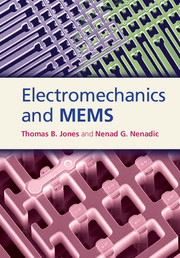Book contents
- Frontmatter
- Contents
- Preface
- 1 Introduction
- 2 Circuit-based modeling
- 3 Capacitive lumped parameter electromechanics
- 4 Small-signal capacitive electromechanical systems
- 5 Capacitive sensing and resonant drive circuits
- 6 Distributed 1-D and 2-D capacitive electromechanical structures
- 7 Practical MEMS devices
- 8 Electromechanics of piezoelectric elements
- 9 Electromechanics of magnetic MEMS devices
- Appendix A Review of quasistatic electromagnetics
- Appendix B Review of mechanical resonators
- Appendix C Micromachining
- Appendix D A brief review of solid mechanics
- Index
- References
5 - Capacitive sensing and resonant drive circuits
Published online by Cambridge University Press: 05 May 2013
- Frontmatter
- Contents
- Preface
- 1 Introduction
- 2 Circuit-based modeling
- 3 Capacitive lumped parameter electromechanics
- 4 Small-signal capacitive electromechanical systems
- 5 Capacitive sensing and resonant drive circuits
- 6 Distributed 1-D and 2-D capacitive electromechanical structures
- 7 Practical MEMS devices
- 8 Electromechanics of piezoelectric elements
- 9 Electromechanics of magnetic MEMS devices
- Appendix A Review of quasistatic electromagnetics
- Appendix B Review of mechanical resonators
- Appendix C Micromachining
- Appendix D A brief review of solid mechanics
- Index
- References
Summary
Introduction
MEMS devices are usually exploited in practical measurement and actuation technologies by integrating them on-chip with the necessary sensing circuitry and electronic drives. While the electromechanical transducer itself is the heart of any MEMS system, its capabilities can be realized only with appropriate amplification, regulation, and signal conditioning. Electronic design has always been central to actuator and sensor technologies, but the development of microfabricated devices has presented new challenges for circuit designers. Devices with dimensions of the order of tens to hundreds of microns have very small capacitances – C < 1 pF – and circuits must be reliably sensitive down to ΔC ~ 10 fF. Further, typical devices fabricated on chips suffer significant parasitics, requiring that serious attention be paid to electrostatic shielding and to the issues of signal strength and noise.
In this chapter, we introduce and analyze some of the basic operational-amplifier-based circuit topologies for capacitive sensing. The presentation focuses on how to integrate the two-port electromechanical models developed in Chapter 4 with simple amplifier circuits. The emphasis is on basic principles at the systems level. The starting point is a brief review of the ideal operational amplifier and its most important circuit implementation, namely, the inverting amplifier configuration. We then apply this very robust and adaptable circuit to the basic DC biased two-plate capacitive sensor, showing that such systems provide good sensitivity but entail the serious problem of large DC voltage offsets. Three-plate sensing schemes are then introduced as a way to avoid DC offsets and to take advantage of the inherent sensitivity of differential measurements.
Information
- Type
- Chapter
- Information
- Electromechanics and MEMS , pp. 150 - 222Publisher: Cambridge University PressPrint publication year: 2013
